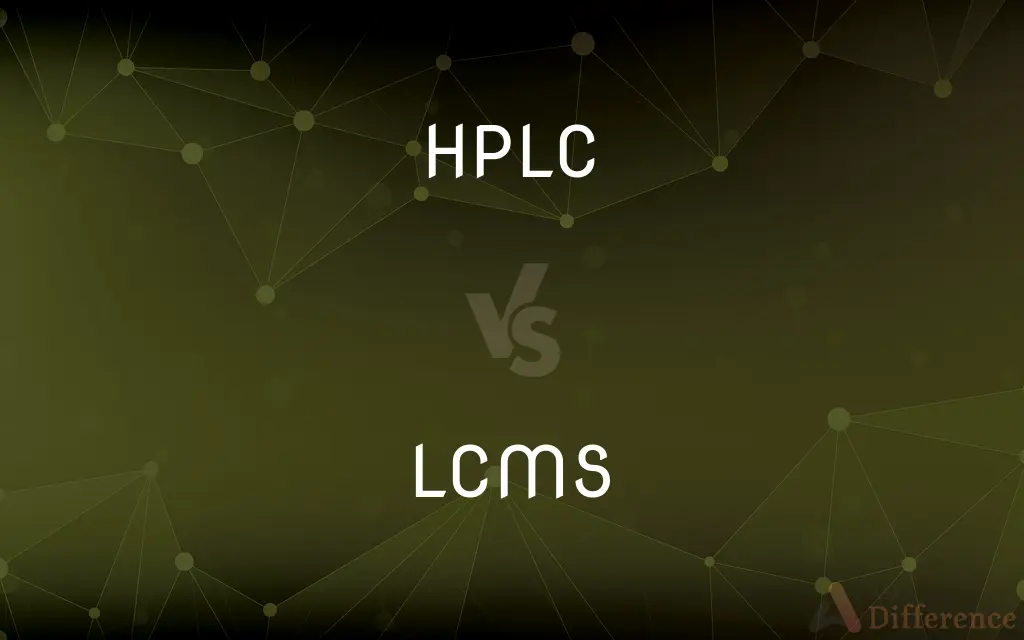HPLC vs. LCMS — What's the Difference?
By Tayyaba Rehman & Urooj Arif — Published on February 17, 2024
HPLC (High Performance Liquid Chromatography) separates components in a mixture; LCMS (Liquid Chromatography-Mass Spectrometry) separates, then identifies and quantifies components using mass spectrometry.

Difference Between HPLC and LCMS
Table of Contents
ADVERTISEMENT
Key Differences
HPLC (High Performance Liquid Chromatography) and LCMS (Liquid Chromatography-Mass Spectrometry) are analytical techniques used to separate, identify, and quantify compounds within a mixture. HPLC focuses on the separation of compounds based on their interaction with the column's stationary phase and the mobile phase. It is highly effective for separating a wide variety of chemical mixtures and is widely used in industries such as pharmaceuticals, environmental testing, and food analysis. The technique allows for the precise separation of compounds but does not inherently provide detailed information about the chemical structure of the separated compounds.
LCMS combines the separation capabilities of liquid chromatography (LC) with the detection capabilities of mass spectrometry (MS). After separation by LC, compounds are ionized and then introduced into the mass spectrometer, which identifies and quantifies them based on their mass-to-charge ratio. This combination offers a powerful tool for the analysis of complex mixtures, providing not only separation but also detailed structural information about the molecules present. LCMS is particularly useful for identifying unknown compounds, quantifying low levels of compounds in complex matrices, and studying the molecular structure of analytes.
The primary difference between HPLC and LCMS lies in their detection mechanisms and the information they provide. HPLC, while versatile in separation, relies on detectors that measure absorbance, fluorescence, or refractive index changes; it does not provide molecular mass information. LCMS, however, through its mass spectrometry component, can offer detailed molecular information, including structural and quantitative data, making it invaluable for more complex analyses where identification is crucial.
Choosing between HPLC and LCMS depends on the analytical needs. HPLC is suitable for routine separation and quantification when the compounds of interest are known and standards are available. LCMS is chosen when the analysis requires structural elucidation, identification of unknowns, or when dealing with very low concentrations of analytes. The selection is also influenced by the complexity of the sample, with LCMS being more adept at handling complex biological matrices.
In summary, while both HPLC and LCMS are essential tools in analytical chemistry, their application is dictated by the specific requirements of the analysis. HPLC excels in separating compounds, whereas LCMS extends this capability with comprehensive identification and quantification, making it a powerful technique for advanced analytical challenges.
ADVERTISEMENT
Comparison Chart
Primary Function
Separation of compounds
Separation followed by identification and quantification
Detection Method
UV, fluorescence, refractive index, etc.
Mass spectrometry
Information Provided
Concentration, purity
Molecular weight, structure, concentration
Sample Complexity
Suitable for less complex mixtures
Handles complex mixtures well
Application Fields
Pharmaceuticals, food analysis, environmental testing
Bioanalysis, pharmaceuticals, metabolomics
Compare with Definitions
HPLC
Essential in quality control and analytical research.
HPLC ensures the consistency and purity of our product batches.
LCMS
Ideal for identifying unknown substances in complex mixtures.
The unknown compound was finally characterized using LCMS.
HPLC
Utilizes high pressure to push solvents through a column.
The high pressure in HPLC enables efficient separation of analytes.
LCMS
Offers both qualitative and quantitative data on compounds.
Through LCMS, we quantified trace levels of pesticides in water.
HPLC
Can be adapted with various detectors for specific analyses.
We attached a UV detector to the HPLC system for our experiment.
LCMS
Enables the study of molecular structures and interactions.
LCMS provided insights into the drug-receptor interaction mechanisms.
HPLC
A technique for separating chemical compounds in a mixture.
HPLC was used to purify the pharmaceutical compounds.
LCMS
Combines liquid chromatography with mass spectrometry for analysis.
LCMS uniquely identified the metabolic products in the sample.
HPLC
Versatile in separating a wide range of molecular sizes.
From small ions to large biomolecules, HPLC handles them all.
LCMS
Widely used in pharmacokinetics and proteomics research.
LCMS has revolutionized our approach to proteomics studies.
Common Curiosities
What makes LCMS unique compared to HPLC?
Its ability to provide molecular weight and structure information.
What is LCMS used for?
Identifying, characterizing, and quantifying compounds in a mixture.
What sample types can be analyzed by LCMS?
Biological fluids, environmental samples, food products, and pharmaceuticals.
What does HPLC stand for?
High Performance Liquid Chromatography.
Can HPLC identify unknown compounds?
Not directly; it requires comparison to known standards.
What industries use HPLC?
Pharmaceutical, environmental, food and beverage, and more.
How does HPLC separate compounds?
Based on their interaction with the stationary and mobile phases.
How are samples prepared for HPLC analysis?
They often require purification and dilution to suit the analytical conditions.
What type of detectors can be used with HPLC?
UV-Vis, fluorescence, and refractive index detectors, among others.
How does the choice between HPLC and LCMS affect the outcome of an analysis?
It depends on the analytical goals: HPLC for separation and quantification, LCMS for in-depth analysis including identification and quantification at trace levels.
Is LCMS more sensitive than HPLC?
Yes, especially for detecting and quantifying low-concentration analytes.
Why is LCMS preferred in bioanalysis?
For its sensitivity, specificity, and ability to handle complex biological matrices.
Can LCMS analyze proteins and peptides?
Yes, it's particularly useful for studying large biomolecules like proteins.
What are the limitations of HPLC?
It lacks the ability to provide structural information about analytes.
How does mass spectrometry in LCMS work?
It ionizes chemical compounds to measure their mass-to-charge ratio.
Share Your Discovery

Previous Comparison
Verb Phrase vs. Phrasal Verb
Next Comparison
RQ vs. RERAuthor Spotlight
Written by
Tayyaba RehmanTayyaba Rehman is a distinguished writer, currently serving as a primary contributor to askdifference.com. As a researcher in semantics and etymology, Tayyaba's passion for the complexity of languages and their distinctions has found a perfect home on the platform. Tayyaba delves into the intricacies of language, distinguishing between commonly confused words and phrases, thereby providing clarity for readers worldwide.
Co-written by
Urooj ArifUrooj is a skilled content writer at Ask Difference, known for her exceptional ability to simplify complex topics into engaging and informative content. With a passion for research and a flair for clear, concise writing, she consistently delivers articles that resonate with our diverse audience.
















































